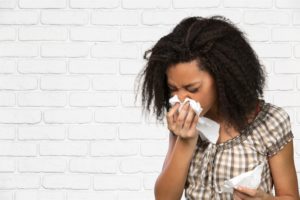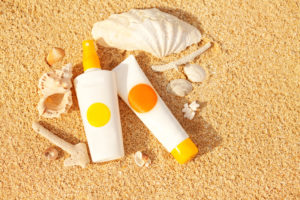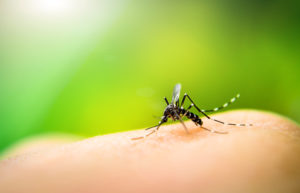 Allergens (i.e., antigens) that are commonly found in the Washington, DC, Northern Virginia, and Maryland metropolitan area in the Summer may include: pollens, molds, dust mites, pets, cockroaches, stinging insects (e.g., bees, wasps, yellow jackets, white-faced hornets, yellow-faced hornets), and non-stinging insects (e.g., mosquitoes, gnats).
Allergens (i.e., antigens) that are commonly found in the Washington, DC, Northern Virginia, and Maryland metropolitan area in the Summer may include: pollens, molds, dust mites, pets, cockroaches, stinging insects (e.g., bees, wasps, yellow jackets, white-faced hornets, yellow-faced hornets), and non-stinging insects (e.g., mosquitoes, gnats).
Non-allergens (i.e., irritants) that cause allergy-like symptoms and/or asthma, that are found in the Summer in the Washington, DC metro area may include: smog, smoke, ozone, diesel fuel, dust particulates, and automobile exhaust.
Grass pollens are more prevalent in the early Summer, whereas ragweed pollen generally begins to pollinate in the middle of August and typically ends in late October with the arrival of the first frost. There are also small amounts of tree pollens that linger in the air during the beginning of the Summer in the Washington, DC metro area, although characteristically, tree pollens wreak havoc mostly in the Spring.
Molds are omnipresent in the greater Washington, DC metropolitan area since Washington, DC was built on a swamp. In the Summer, there is higher humidity, along with warmer temperatures which provides the perfect condition for mold growth. Molds are also found indoors and tend to gravitate to places such as basements, kitchens, and bathrooms where moisture may be worse.
Dust mites (e.g., Dermatophagoides farinae, Dermatophagoides pteronyssinus) are microscopic bugs that tend to live in carpeting, fabrics, and bedding. They live off of dead skin that naturally sloughs off of humans and animals. They will also eat molds. Dust mites reach their peak concentrations during the Summer and thrive in the warm, humid environment that Washington, DC is famous for in the Summer.
Cats, dogs, horses, and furry pets (i.e., hamsters, guinea pigs, rats, mice, ferrets) are a source of allergens throughout the year, because they are generally kept indoors, except for horses. As the weather warms up, people tend to go horseback riding more often, so people tend to complain of allergies to horses more often during the warmer months of Summer. In addition to the actual pet allergy itself, cats and dogs often transfer pollens on their furry coats from the outside to the inside of one’s home which may add to the misery of a particular allergic individual.
Cockroaches are very common in homes, restaurants, and stores especially in inner city locations such as Washington, DC. They are highly allergenic and are responsible for exacerbating asthma, particularly in asthmatic children who live in the inner cities.
Stinging insects are also more common in the Summer. Bees, wasps, yellow jackets, white-faces hornets, and yellow-faced hornets are always around during this time of year. They tend to like being around food and tend to be found quite often at picnic grounds, barbeques, swimming pools. They also are found near gardens, lawns, and parks. Note that stinging insects can be anywhere and sensitive individuals should always practice avoidance measures and carry an epinephrine auto-injector (e.g., EpiPen, Auvi-Q, Adrenaclick), if prescribed by an allergist such as the board certified allergists at Black & Kletz Allergy. If an individual uses their epinephrine auto-injector, they should immediately go to the closest emergency room. Life-threatening anaphylactic reactions (i.e., anaphylaxis) to stinging insects do occur and anyone who has had any type of systemic reaction in the past to a stinging insect should definitely see a board certified allergist for venom testing and possible venom immunotherapy (i.e. “bee shots”), since venom immunotherapy is highly effective in preventing anaphylactic reactions with future stings.
Non-stinging insects such as mosquitoes are more prevalent in the Summer and tend to migrate near standing fresh water. Even a small puddle is enough standing water to act as a reservoir for the breeding of mosquitoes. Most of the reactions to non-stinging insects involve a local redness and/or swelling of the skin. There may be pain and/or itching associated with the bites. In rarer situations, an individual may experience an anaphylactic reaction. If this occurs it is important to use an epinephrine auto-injector and immediately go to the closest emergency room.
Non-allergens (i.e., irritants) such as smog, smoke, ozone, diesel fuel, dust particulates, and automobile exhaust also may cause allergy-like and/or asthma symptoms in many susceptible individuals. Automobile exhaust in combination with the heat of summer and ultraviolet (UV) rays of the sun contribute greatly to increased levels of ozone and smog. In addition to ozone and smog, dust particulates and smoke are two more non-allergic irritants that contribute to air pollution. Air pollution is unhealthy to human life when the pollution level or air quality index (i.e., AQI) rises to above 150. Note that the AQI ranges from 0 to 500. AQI’s above 100 are unhealthy for certain sensitive groups of people (e.g., people with lung disease). AQI’s above 300 are hazardous to everyone.
The board certified allergy specialists at Black & Kletz Allergy have over 50 years’ experience in the diagnosis and treatment of environmental allergies and insect sting and bite allergies. Although these conditions may be more prevalent in the Summer, environmental allergies are a perennial problem and most sensitive individuals have year-round symptoms. Black & Kletz Allergy specializes in both adults and children who have allergies and/or asthma. We have 3 locations in the Washington, DC, Northern Virginia, and Maryland metropolitan area. Our offices are located in Washington, DC, McLean, VA (Tysons Corner, VA), and Manassas, VA. There is on-site parking at each location and the Washington, DC and McLean offices are Metro accessible. There is also a free shuttle that runs between our McLean, VA office and the Spring Hill metro station on the silver line.
If you would like us to help you with your allergies and/or asthma, please call us at one of our office locations that are convenient for you. Alternatively, you can click Request an Appointment and we respond within 24 hours by the next business day. We are here in order for us to make your Summers more enjoyable by eliminating or markedly reducing your allergy and/or asthma symptoms.
 Sunscreen is something that you need to wear to protect your skin from the sun’s harmful UV rays, but not all sunscreen is created equal. Some people might have no problem wearing it, but it’s also possible for your skin to have a bad reaction to the common ingredients in most sunscreen formulas. You might not be aware that sunscreen chemicals are added to some other cosmetic or lotion products, which can cause you to have an allergic reaction.
Sunscreen is something that you need to wear to protect your skin from the sun’s harmful UV rays, but not all sunscreen is created equal. Some people might have no problem wearing it, but it’s also possible for your skin to have a bad reaction to the common ingredients in most sunscreen formulas. You might not be aware that sunscreen chemicals are added to some other cosmetic or lotion products, which can cause you to have an allergic reaction.
 Allergens (i.e., antigens) that are commonly found in the
Allergens (i.e., antigens) that are commonly found in the  The onset of summer brings with it the menace of mosquitoes. Though we are more concerned about diseases transmitted by mosquitoes such as malaria, encephalitis, dengue fever, chikungunya, West Nile virus, yellow fever, filariasis (elephantiasis), Western equine encephalitis, Eastern equine encephalitis, Japanese encephalitis, Venezuelan equine encephalitis, St. Louis encephalitis, La Crosse encephalitis, Ross River fever, Rift Valley fever, and most recently Zika virus-related illnesses, adverse reactions to
The onset of summer brings with it the menace of mosquitoes. Though we are more concerned about diseases transmitted by mosquitoes such as malaria, encephalitis, dengue fever, chikungunya, West Nile virus, yellow fever, filariasis (elephantiasis), Western equine encephalitis, Eastern equine encephalitis, Japanese encephalitis, Venezuelan equine encephalitis, St. Louis encephalitis, La Crosse encephalitis, Ross River fever, Rift Valley fever, and most recently Zika virus-related illnesses, adverse reactions to